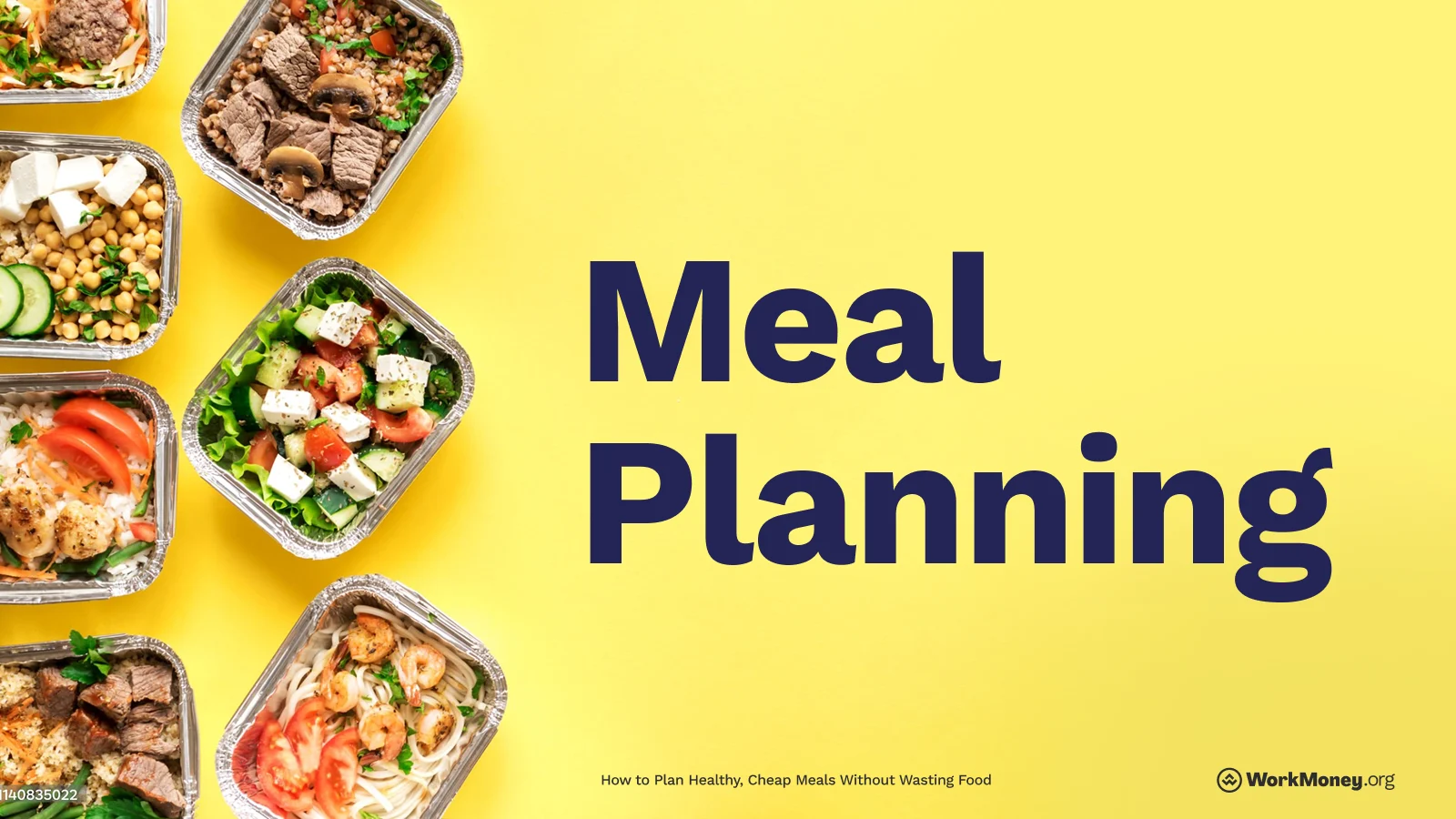How to Plan Healthy, Cheap Meals Without Wasting Food
Learn how to maximize grocery savings using store rewards, digital coupons, and food delivery apps—all without changing where you shop.

Eating healthy on a budget can seem like a challenge, but it’s possible with the right planning. The key is to be intentional with meal planning, make cost-effective choices, and find ways to minimize food waste. Whether you’re feeding a family or just yourself, here are a few steps to help you plan nutritious, affordable meals without throwing food (or money) away.
Step 1: Plan Your Meals in Advance
One of the most effective ways to eat healthily on a budget is by planning your meals for the week. A well-structured meal plan allows you to buy only what you need, reducing impulse purchases and waste. Here’s how to get started:
Assess What You Have: Check your pantry, fridge, and freezer before making a shopping list. Use ingredients that are close to their expiration date first.
Choose Simple, Versatile Recipes: Select meals that share common ingredients to maximize usage. For example, if you buy a bag of spinach, plan multiple meals that use up the entire bag.
Make a Shopping List: Write down exactly what you need and stick to it. Avoid buying in bulk unless you’re confident you can use everything before it expires.
Plan for Leftovers: Designate a day for leftovers or repurpose meals to avoid waste. For example, roasted chicken from one meal can be turned into sandwiches or soup the next day.
Step 2: Buy Smart at the Grocery Store
A key part of planning healthy, affordable meals is making smart choices at the store. Here are some strategies:
Buy Whole Ingredients Instead of Processed Foods: Whole foods like rice, beans, vegetables, and fresh meat are often cheaper and healthier than processed or pre-packaged meals.
Shop Seasonally and Locally: Seasonal produce is fresher, more nutritious, and usually more affordable. Local farmers' markets and discount grocery stores can offer great deals.
Use Digital Coupons and Store Discounts: Check for sales, loyalty programs, and coupons to save on essential ingredients, and don’t forget to check Upside for additional discounts.
Choose Generic Brands: Many generic brands have the same nutritional value as name brands but at a lower price.
Opt for Frozen or Canned Produce: These options last longer and reduce the risk of food going bad before you use it. Just be sure to choose low-sodium canned options and frozen vegetables without added sauces.
Utilize SNAP Benefits Wisely: If you receive benefits through the Supplemental Nutrition Assistance Program (SNAP), maximize your purchasing power by shopping at stores that offer discounts or double-dollar programs for fresh produce. Farmers' markets in some areas also accept SNAP and provide additional incentives.
Step 3: Cook Efficiently and Reduce Waste
Cooking efficiently helps stretch your budget while minimizing waste. Here are some useful tips:
Batch Cooking and Freezing: Prepare large portions of meals and freeze them in individual servings. This saves time and ensures you always have a healthy meal ready.
Use All Parts of Your Ingredients: Use vegetable scraps for homemade broth, and repurpose leftovers into new meals. Overripe fruit can be used in smoothies or baking.
Proper Storage Matters: Store produce correctly to extend its shelf life. For example, keep potatoes in a cool, dark place and store herbs in a glass of water in the fridge.
Understand Expiration Dates: “Best by” and “sell by” dates are often just guidelines. Avoid throwing things away just based on dates, and find out if it's expired.
Avoid wasting money on groceries by using a money-saving app like Upside, where users have earned more than $800 million back.

Step 4: Get Creative with Meals
When planning budget-friendly meals, creativity is key. Try these ideas to make the most of what you have:
Make Stir-Fries and Soups: These meals allow you to use up whatever vegetables or proteins you have on hand.
Try Meatless Meals: Beans, lentils, and tofu are affordable protein sources that can replace expensive meats.
Embrace One-Pot Meals: Dishes like chili, casseroles, or pasta bakes make cooking easier and reduce cleanup.
Have a Leftovers Night: Dedicate one night a week to finishing up any remaining meals to prevent food from going to waste.
Here are a few examples of how to creatively use up the food you have:
Example 1: Suppose you buy a bag of carrots. Instead of letting them go bad in the fridge, use them in multiple meals: chop some into a stir-fry, shred them for a salad, and blend a portion into a soup.
Example 2: If you purchase a whole chicken, roast it for dinner one night, use the leftovers for sandwiches the next day, and then boil the bones to make a flavorful homemade broth for soup.
Example 3: If you’re using SNAP or WIC benefits, you can buy dried beans and whole grains like brown rice or oats. These items are budget-friendly, shelf-stable, and can be used in multiple meals, such as rice and beans, soups, or breakfast porridge.
Here are examples of ingredients that are budget-friendly and able to be used in many different meals:
If you're looking for ingredients that can be used across multiple meals, here are some kitchen staples that work well for different types of dishes:
Proteins
Eggs – Breakfast scrambles, baking, fried rice, ramen, sandwiches
Chicken – Roasted, stir-fries, soups, sandwiches, salads
Ground Beef/Turkey – Tacos, pasta, burgers, meatballs, stir-fries
Tofu – Stir-fries, soups, scrambles, sandwiches
Carbs & Grains
Rice – Side dish, stir-fry base, burrito bowls, soups, fried rice
Pasta – Classic Italian dishes, casseroles, pasta salads
Tortillas – Wraps, quesadillas, tacos, breakfast burritos
Bread – Sandwiches, toast, croutons, bread pudding
Vegetables (Fresh or Frozen)
Onions & Garlic – Base for soups, sauces, stir-fries, curries
Bell Peppers – Stir-fries, fajitas, pasta, omelets, sandwiches
Carrots – Soups, stir-fries, salads, roasting, snacking
Spinach/Kale – Salads, omelets, smoothies, pasta, soups
Potatoes – Mashed, roasted, breakfast hash, fries, soups
Dairy & Dairy Substitutes
Cheese – Sandwiches, pasta, omelets, casseroles, tacos
Milk/Plant Milk – Baking, coffee, oatmeal, sauces
Yogurt – Breakfast bowls, smoothies, marinades, sauces
Pantry Staples (Sauces, Seasonings, & Oils)
Olive Oil/Butter – Cooking, baking, dressing, frying
Soy Sauce – Stir-fries, marinades, dipping sauces
Tomato Paste/Sauce – Pasta, soups, stews, pizza
Beans (Canned or Dried) – Tacos, soups, salads, wraps
Broth (Chicken/Vegetable) – Soups, sauces, cooking grains
Peanut Butter – Toast, smoothies, sauces, baking
Step 5: Learn to Love Meal Prepping
Meal prepping does two things: saves time and reduces the temptation to eat out. Follow these steps to streamline your meal prep routine:
Pick a Day to Prep: Choose one day a week to prepare meals in advance.
Cook Staples in Bulk: Make large batches of grains, proteins, and vegetables that can be mixed and matched throughout the week.
Pre-Portion Meals: Divide meals into containers for easy grab-and-go options.
Use Mason Jars for Salads: Layer ingredients so that they stay fresh for longer.
Here are three quick food prep hacks to save time and stress:
Batch-cook your proteins with simple seasoning so you can reuse them in different meals all week.
Pre-chop veggies and store them in water to keep them fresh and ready to toss into any dish.
Build a grab-and-go snack bin with preportioned options to save time and curb cravings.
Bonus: Think About Signing Up For Meal Subscription Boxes
Food delivery can come with a cost premium, but a few may fit your budget. These can help save you time at the grocery store, help you avoid waste, and steer you away from boredom with your meal choices.
Many of these subscription-based services often run promotions, so look out for ways to cut your initial costs.
Final Thoughts
Planning healthy, budget-friendly meals while minimizing food waste is all about planning. By planning ahead, making smart grocery purchases, cooking efficiently, and getting creative with meals, you can eat nutritious food without overspending or wasting food. If you have access to support programs like SNAP, take advantage of store discounts and farmers' market incentives to stretch your benefits even further. This approach can help you save money and lead a healthy lifestyle at the same time.
About the Author

Brett Holzhauer
Brett Holzhauer is a Certified Personal Finance Counselor (CPFC) who has reported for outlets like CNBC Select, Forbes Advisor, LendingTree, UpgradedPoints, MoneyGeek and more throughout his career. He is an alum of the Walter Cronkite School of Journalism at Arizona State. When he is not reporting, Brett is likely watching college football or traveling.

